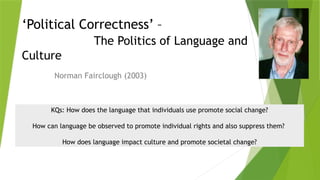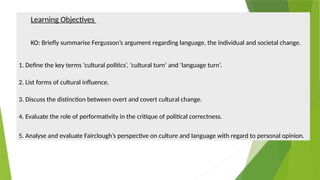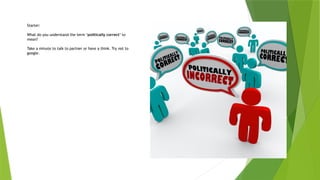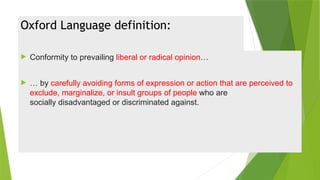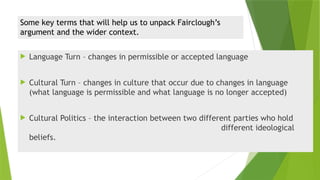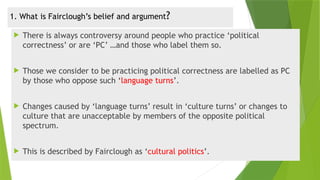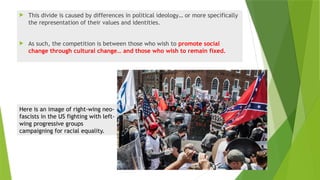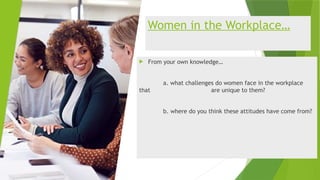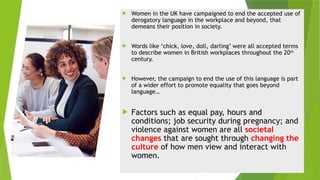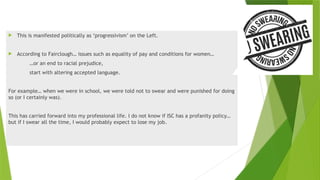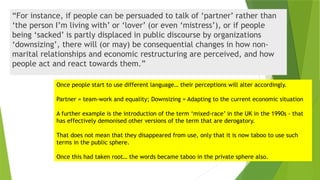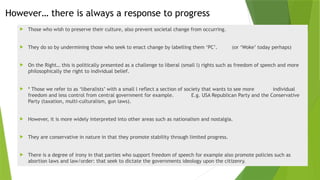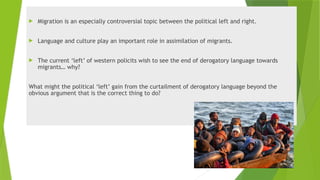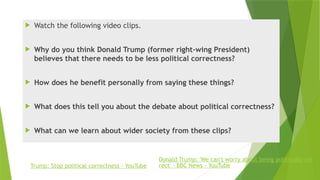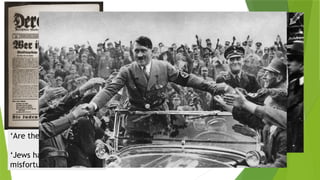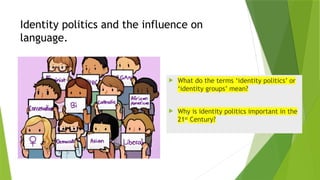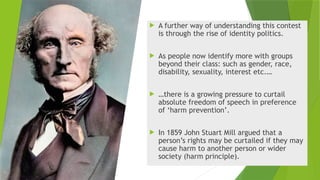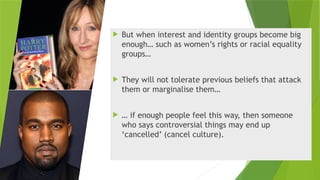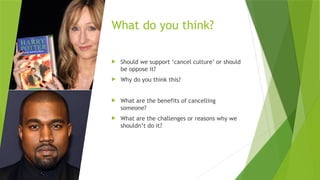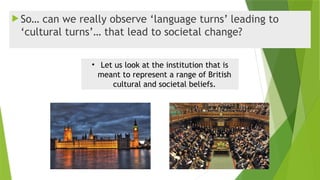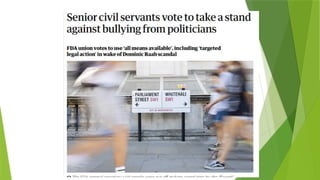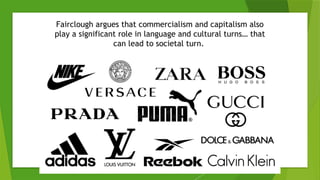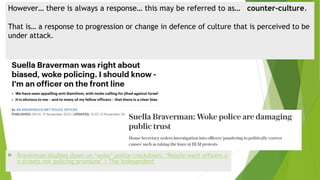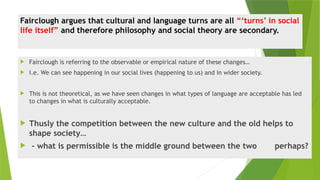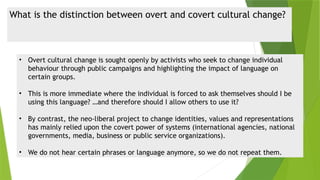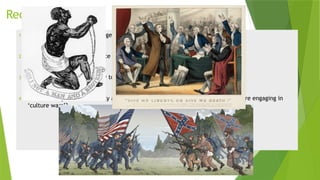Political Correctness’ – The Politics of.pptx
- 1. ‘Political Correctness’ – The Politics of Language and Culture Norman Fairclough (2003) KQs: How does the language that individuals use promote social change? How can language be observed to promote individual rights and also suppress them? How does language impact culture and promote societal change?
- 2. Learning Objectives KO: Briefly summarise Fergusson’s argument regarding language, the individual and societal change. 1. Define the key terms ‘cultural politics’, ‘cultural turn’ and ‘language turn’. 2. List forms of cultural influence. 3. Discuss the distinction between overt and covert cultural change. 4. Evaluate the role of performativity in the critique of political correctness. 5. Analyse and evaluate Fairclough’s perspective on culture and language with regard to personal opinion.
- 3. Starter: What do you understand the term ‘politically correct’ to mean? Take a minute to talk to partner or have a think. Try not to google.
- 4. Oxford Language definition:  Conformity to prevailing liberal or radical opinion…  … by carefully avoiding forms of expression or action that are perceived to exclude, marginalize, or insult groups of people who are socially disadvantaged or discriminated against.
- 5. Some key terms that will help us to unpack Fairclough’s argument and the wider context.  Language Turn – changes in permissible or accepted language  Cultural Turn – changes in culture that occur due to changes in language (what language is permissible and what language is no longer accepted)  Cultural Politics – the interaction between two different parties who hold different ideological beliefs.
- 6. 1. What is Fairclough’s belief and argument?  There is always controversy around people who practice ‘political correctness’ or are ‘PC’ …and those who label them so.  Those we consider to be practicing political correctness are labelled as PC by those who oppose such ‘language turns’.  Changes caused by ‘language turns’ result in ‘culture turns’ or changes to culture that are unacceptable by members of the opposite political spectrum.  This is described by Fairclough as ‘cultural politics’.
- 7.  This divide is caused by differences in political ideology… or more specifically the representation of their values and identities.  As such, the competition is between those who wish to promote social change through cultural change… and those who wish to remain fixed. Here is an image of right-wing neo- fascists in the US fighting with left- wing progressive groups campaigning for racial equality.
- 8. Women in the Workplace…  From your own knowledge… a. what challenges do women face in the workplace that are unique to them? b. where do you think these attitudes have come from?
- 9.  Women in the UK have campaigned to end the accepted use of derogatory language in the workplace and beyond, that demeans their position in society.  Words like ‘chick, love, doll, darling’ were all accepted terms to describe women in British workplaces throughout the 20th century.  However, the campaign to end the use of this language is part of a wider effort to promote equality that goes beyond language…  Factors such as equal pay, hours and conditions; job security during pregnancy; and violence against women are all societal changes that are sought through changing the culture of how men view and interact with women.
- 10.  This is manifested politically as ‘progressivism’ on the Left.  According to Fairclough… issues such as equality of pay and conditions for women… …or an end to racial prejudice, start with altering accepted language. For example… when we were in school, we were told not to swear and were punished for doing so (or I certainly was). This has carried forward into my professional life. I do not know if ISC has a profanity policy… but if I swear all the time, I would probably expect to lose my job.
- 11. “For instance, if people can be persuaded to talk of ‘partner’ rather than ‘the person I’m living with’ or ‘lover’ (or even ‘mistress’), or if people being ‘sacked’ is partly displaced in public discourse by organizations ‘downsizing’, there will (or may) be consequential changes in how non- marital relationships and economic restructuring are perceived, and how people act and react towards them.” Once people start to use different language… their perceptions will alter accordingly. Partner = team-work and equality; Downsizing = Adapting to the current economic situation A further example is the introduction of the term ‘mixed-race’ in the UK in the 1990s - that has effectively demonised other versions of the term that are derogatory. That does not mean that they disappeared from use, only that it is now taboo to use such terms in the public sphere. Once this had taken root… the words became taboo in the private sphere also.
- 12. However… there is always a response to progress  Those who wish to preserve their culture, also prevent societal change from occurring.  They do so by undermining those who seek to enact change by labelling them ‘PC’. (or ‘Woke’ today perhaps)  On the Right… this is politically presented as a challenge to liberal (small l) rights such as freedom of speech and more philosophically the right to individual belief.  * Those we refer to as ‘liberalists’ with a small l reflect a section of society that wants to see more individual freedom and less control from central government for example. E.g. USA Republican Party and the Conservative Party (taxation, multi-culturalism, gun laws).  However, it is more widely interpreted into other areas such as nationalism and nostalgia.  They are conservative in nature in that they promote stability through limited progress.  There is a degree of irony in that parties who support freedom of speech for example also promote policies such as abortion laws and law/order: that seek to dictate the governments ideology upon the citizenry.
- 13.  Migration is an especially controversial topic between the political left and right.  Language and culture play an important role in assimilation of migrants.  The current ‘left’ of western policits wish to see the end of derogatory language towards migrants… why? What might the political ‘left’ gain from the curtailment of derogatory language beyond the obvious argument that is the correct thing to do?
- 14.  Watch the following video clips.  Why do you think Donald Trump (former right-wing President) believes that there needs to be less political correctness?  How does he benefit personally from saying these things?  What does this tell you about the debate about political correctness?  What can we learn about wider society from these clips? Trump: Stop political correctness - YouTube Donald Trump: 'We can't worry about being politically cor rect' - BBC News - YouTube
- 15. ‘Are they an enemy?’ ‘Jews have caused our misfortune!’
- 16.  This diagram reflects ‘rightist’ perspectives on PC culture.  What can we learn from this diagram about the importance of language?  What about identity in the struggle between progressivism and conservativism?
- 17. Identity politics and the influence on language.  What do the terms ‘identity politics’ or ‘identity groups’ mean?  Why is identity politics important in the 21st Century?
- 18.  A further way of understanding this contest is through the rise of identity politics.  As people now identify more with groups beyond their class: such as gender, race, disability, sexuality, interest etc.…  …there is a growing pressure to curtail absolute freedom of speech in preference of ‘harm prevention’.  In 1859 John Stuart Mill argued that a person’s rights may be curtailed if they may cause harm to another person or wider society (harm principle).
- 19.  Identity groups have become large, informal associations today… with people who have never met, identifying with strangers in other parts of the country or world.  They are organised at a grass-roots (low) level into small cells that combine to perform social actions such as protest.  As these groups now encompass many people, who may be a part of several groups… an individual’s words will now harm enough people that society will not allow those words to continue unchallenged.  As identity groups have come into existence and have become a conscious part of people’s political ideology… there is a contest to achieve equality or social justice with other elements of society… such as other interest groups or more normative assumptions like capitalism.  For example… protestors campaigning to end child slavery while making calls on IPhones and wearing Nike clothing.  This is in contest with social norms that allowed an individual to speak as they wished, as they had not faced significant opposition and so could say what they liked (20th Century).
- 20.  But when interest and identity groups become big enough… such as women’s rights or racial equality groups…  They will not tolerate previous beliefs that attack them or marginalise them…  … if enough people feel this way, then someone who says controversial things may end up ‘cancelled’ (cancel culture).
- 21. What do you think?  Should we support ‘cancel culture’ or should be oppose it?  Why do you think this?  What are the benefits of cancelling someone?  What are the challenges or reasons why we shouldn’t do it?
- 22.  So… can we really observe ‘language turns’ leading to ‘cultural turns’… that lead to societal change? • Let us look at the institution that is meant to represent a range of British cultural and societal beliefs.
- 24. Peter Bone: Abuse by MP left me broken, former aide say s - BBC News
- 25. The ‘Language and Culture Turns’  Fairclough argues that an alteration in the types of language that we use has had an impact on the very society we see in the West today.  As we have seen, cultural turns are moments where societal perceptions or values change… and this can be motivated by changes to language.  Fairclough argues we can observe these changes in:  Firstly… the ‘culture industries’… what do you think a ‘cultural industry’ is? … can you think of any new ‘cultural industries’ that influence permissible language and therefore publicly approved attitudes?
- 26.  Today, social media plays a significant part in facilitating or blocking language turns that lead to cultural turns.  Can you explain why social media has such an important role…?  …and why it may be helping or blocking language turns and cultural turns?
- 27. Fairclough argues that commercialism and capitalism also play a significant role in language and cultural turns… that can lead to societal turn.
- 29. E.g. Nike and Black Heritage  Following the death of African American George Floyd in the US in May 2020…  Black Lives Matter protests swept the globe… and companies like Nike, Pepsi and the Premier League were eager to capitalise on the engagement people had with the civil rights movement.  Nike BHM. Black History Month. Nike.com  Kendall Jenner Pepsi Ad (youtube.com)  Why Premier League Players Take The Knee (youtube.com)
- 30. However… there is always a response… this may be referred to as… counter-culture. That is… a response to progression or change in defence of culture that is perceived to be under attack.  Braverman doubles down on ‘woke’ police crackdown: ‘People want officers o n streets not policing pronouns’ | The Independent
- 31. • Why do you think commercialism and capitalism may play a role in cultural turns? • Do you agree with Fairclough? …or do you think companies also play a role in maintaining a static society?
- 33. Fairclough argues that cultural and language turns are all “‘turns’ in social life itself” and therefore philosophy and social theory are secondary.  Fairclough is referring to the observable or empirical nature of these changes…  I.e. We can see happening in our social lives (happening to us) and in wider society.  This is not theoretical, as we have seen changes in what types of language are acceptable has led to changes in what is culturally acceptable.  Thusly the competition between the new culture and the old helps to shape society…  - what is permissible is the middle ground between the two perhaps?
- 34. What is the distinction between overt and covert cultural change? • Overt cultural change is sought openly by activists who seek to change individual behaviour through public campaigns and highlighting the impact of language on certain groups. • This is more immediate where the individual is forced to ask themselves should I be using this language? …and therefore should I allow others to use it? • By contrast, the neo-liberal project to change identities, values and representations has mainly relied upon the covert power of systems (international agencies, national governments, media, business or public service organizations). • We do not hear certain phrases or language anymore, so we do not repeat them.
- 35. Performativism and PC-ness  Fairclough argues that one criticism of those seeking to change society - through the change of language - is that they are merely ‘performing’… … this has given rise to the term ‘virtue signalling’.  What do you think this means?  Do you agree with the critics who accuse ‘PC-ers’ of being performers? Why… why not? (try to think about what Fairclough is saying about how society changes)
- 36. Recap… 1. What do we mean by ‘language turns’ and ‘cultural turns’? 2. How do these ‘turns’ influence societal change…? 3. How does counter-culture try to maintain a static societal position? 4. Can we really describe society as ‘stable’ if two sides of the political spectrum are engaging in ‘culture wars’? … or has it always been this way?
